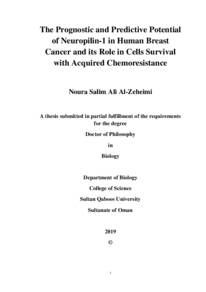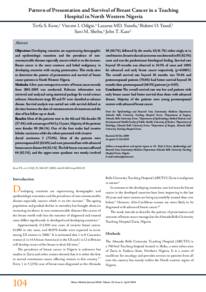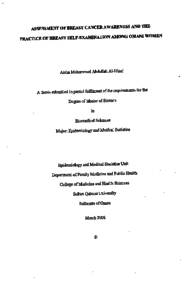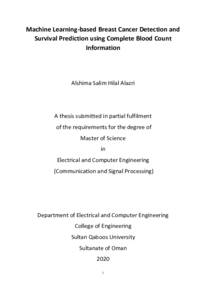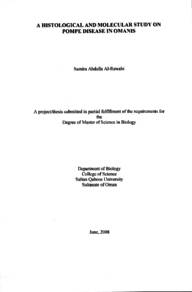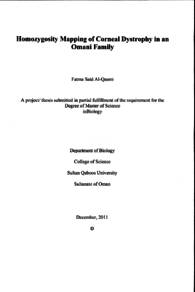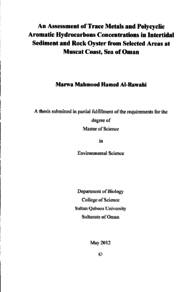Document
The prognostic and predictive potential of neuropilin-1 in human breast cancer and its role in cells survival with acquired chemoresistance
Publisher
Sultan Qaboos University
Gregorian
2019
Language
English
Subject
English abstract
Breast cancer is a heterogeneous disease with various pathological features and molecular profiling. Patients with locally advanced disease are treated with preoperative cycles of neoadjuvant chemotherapy (NAC) regardless of their molecular subtype and thus their response varies. Hence, we aimed to validate appropriate biomarkers involved in tumor progression, response or resistance to NAC as new therapeutic targets to promote a more precise management of patients who don't respond to the commonly used regimens. To achieve the main aim of the study we followed two different routes; clinical and in vitro translational studies.
Neuropilin-1 (NRP-1) is a multifunctional glycoprotein receptor expressed in several cancers and acts as a ligand for several molecules such as vascular endothelial growth factors (VEGF), class III/V1 semaphorins and transforming growth factor β (TGFβ). However, NRP-1 systematic levels and its association with breast cancer characteristics were not yet fully investigated. A cross-sectional study was conducted to validate NRP-1 and its associated molecules as potential biomarkers. Blood and tissue samples of breast cancer patients and age matched healthy individuals were used to measure the levels of NRP-1 and its co-receptors; placenta growth factor (PlGF),VEGF and TGFβ in circulating plasma and peripheral blood mononuclear (PBMCs) cells. The main findings of this study revealed that both plasma NRP-1 and PlGF levels were increased significantly in patients with advanced nodal and metastatic disease. In addition, in tissue sections, the expression of NRP-1 and PlGF increased in triple negative subtype compared to other breast cancer molecular subtypes. Conversely, in PBMCs, NRP-1 and its interacting molecules; class V1 semaphorin (SEMA4A) and EMT regulator, Zinc finger protein SNAI1 (SNAI1) were significantly downregulated in breast cancer patients compared to healthy controls, indicating a protective role. Moreover, we report differential PBMC expression profiles that correlate inversely with disease stage (SEMA4A, SNAI1, PLXNA1 and VEGFR3) and can differentiate between the triple negative breast cancer (TNBC) and non-TNBC tumor subtypes (VEGFR3 and PLXNA1). This work supports the importance of NRP-1-associated molecules in circulation to characterize poor prognosis breast cancer and emphasizes on their role as favorable drug targets.
To understand the relationship of NRP-1 and PlGF with patients' response to chemotherapy, plasma and tissue samples were collected before and after NAC and compared with patients' response and survival data. The results revealed that elevated NRP-1 levels in the tissue post NAC were significantly correlated with poor patients' survival. Similarly, patients who remained with high plasma levels of NRP- 1 post NAC responded partially to the treatment and those who were presented with low levels of NRP-1 responded completely, which indicates that NRP-1 can be a potential pharmacodynamic biomarker for breast cancer. We found that SNAI1 expression in PBMCs in patients who received NAC was significantly increased, especially in patients who showed a complete pathological response to the treatment but did not increase in those who had a partial response, which indicates that SNAI1 might be a good candidate to be used as a predictive marker for a complete pathological response.
In an in vitro translational study, the role of NRP-1 in triggering NAC resistance was also determined by generating resistant variant cells to the commonly used drugs in neoadjuvant setting. Our data revealed distinct mechanisms of resistance depending on breast cancer subtype and drugs used. Adriamycin/cyclophosphamide (4xAC) and Paclitaxel (4xAC+4xPAC) resistant MDA-MB-231 and 4xAC resistant BT-474 cells activated NRP-1/Integrin β3/FAK/NF-κBp65 axis. In turn, resistant MCF7 cells to Adriamycin/cyclophosphamide (4xAC), induced HER-2 expression which converted MCF7 subtype from being a luminal A to luminal B-HER-2 type and upregulated NRP-1, ER-α, and EGFR and activated PI3K/Akt/NF-κBp65 survival axis. Unlike resistant MDA-MB-231 cells, resistant MCF7 and BT-474 cells upregulated BCRP/ABCG2 only upon Paclitaxel treatment. Co-Immunoprecipitation demonstrated a novel interaction between HER-2 and NRP-1 which drives the resistance features. NRP-1 transfected BT-474 (BT-474 NRP-1) cells sensitized the cells to chemotherapy and the resistant cells inactivated NRP-1/Integrin β3/FAK/NF- κBp65 survival axis.
Additionally, the knockout of NRP-1 in MDA-MB-231 cells sensitized them to the AC and PAC treatment, validating our clinical data in which, patients with low levels of NRP-1 responded better to NAC than patients with higher NRP-1 levels.
This study pin pointed the significance of circulating NRP-1-associated molecules (PlGF, SNAI1, SEMA4A, VEGFR3, PLXNA1) to characterize poor prognosis breast cancer, predicts response and survival and thus, emphasizes on their role as favorable drug targets to increase the treatment success of refractory breast cancer. The study highlighted the role of NRP-1 in driving the mechanisms of acquired resistance to NAC in different breast cancer subtypes.
Member of
Resource URL
Arabic abstract
يصنف سرطان الثدي كمرض غير متجانس يحمل العديد من الميزات المرضية والأنماط الفرعية الجزيئية. يتم علاج مريضات سرطان الثدي اللاتي يتم تشخيصهن في مرحلة متقدمة بجرعات من العلاج الكيماوي المطور قبل الجراحة بغض النظر عن النوع الجزيئي الذي تحمله المريضة؛ وبالتالي تختلف نسبة إستجابة المريضات للعلاج، تهدف هذه الدراسة إلى التحقق من دور العلامات الحيوية التي تسهم في تطور الورم أو تتنبئ بالإستجابة أو المقاومة للعلاج الكيماوي، وإعتبارها كأهداف علاجية جديدة لتعزيز مكافحة المرض بدقة عالية وخصوصا للمريضات اللاتي لا يستجبن للعلاج الكيماوي المستخدم حاليا. لتحقيق الهدف الرئيسي للدراسة، إتبعنا منهجين مختلفين؛ الدراسات السريرية والدراسات المخبرية
إن الجزيئات المذابة في الدم تعطي لمحة مفيدة عن الحالة الفسيولوجية للجسم؛ لذلك قمنا بجمع عينات دم من مريضات سرطان الثدي للبحث عن الجزيئات التي من المحتمل أن تسهم في تطور المرض أو تتنبئ بالإستجابة للعلاج الكيماوي وتكون كعلامات حيوية لسرطان الثدي. لأكثر من عقد من الزمان، تم دراسة الجزيء المعروف بالنيوروبیلین 1-NRP - 1 ) Neuropilin ) وقد أثبتت الدراسات السابقة أن زيادة التعبير الجيني أو البروتيني لهذا الجزيء مرتبط بتطور السرطانات المراحل متقدمة مما يصعب علاجها. لكن حتى الان لم يتم التحقق بشكل كلي من دور هذا الجزيئ المذاب في الدم والجزيئات الأخرى المرتبطة به في زيادة أو تقليل خطورة السرطان ودورها كمؤشرات حيوية للتنبؤ بالإستجابة للعلاج.
أجرينا دراسة واسعة للتحقق من دور 1-NRP والجزيئات المرتبطة به إما كمؤشرات حيوية للمرض أوكعلامات تنبؤية للعلاج الكيماوي. أجريت الدراسة على عينات دم وأنسجة من مريضات سرطان الثدي والنساء السليمات المتطابقات في العمر لقياس مستويات 1-NRP و الجزيئات المرتبطة به، VEGF، PIGF و TGFB في بلازما الدم و الخلايا المناعية الموجودة في الدم (PBMCs). كشفت النتائج الرئيسية لهذه الدراسة أن كلا من مستويات جزيئي1-NRP و PIGF في بلازما الدم تزداد بشكل كبير في المريضات اللاتي انتشر الورم لديهن إلى العقد اللمفاوية المحيطة أو الأعضاء الأخرى. بالإضافة إلى ذلك، لوحظ زيادة في مستويات جزيئي 1-NRP و PIGF في النوع الفرعي السلبي الثلاثي لسرطان الثدي مقارنة بالأنواع الفرعية الجزيئية الأخرى. وعلى العكس في خلايا الدم المناعية، لوحظ زيادة التعبير الجيني ل 1-NRP و الجزيئات المرتبطة به؛
SEMA4A و SNAIL بشكل كبير في النساء السليمات ومريضات سرطان الثدي في المراحل المبكرة مقارنة بالمريضات في المراحل المتقدمة من المرض، مما يشير إلى الدور الوقائي لهذه الجزيئات. وبإستخدام التحليل الإحصائي وجدنا زيادة في التعبير الجيني لجزيئي PLYNA1 و VEGFR3 في النوع الفرعي السلبي الثلاثي السرطان الثدي مقارنة بالأنواع الفرعية الأخرى. هذا العمل يدعم أهمية الجزيئات المرتبطة ب 1-NRP في الدم لوصف وتمييز المراحل المختلفة، والانواع الفرعية لسرطان الثدي و يؤكد على دورها كأهداف مستقبيلة تستخدم في العلاج الموجه الفهم العلاقة بين مستويات الجزيئات (1-NRP و PIGF) و الإستجابة للعلاج الكيماوي ، تم جمع عينات بلازما الدم والأنسجة قبل وبعد العلاج الكيماوي ومقارنتها مع بيانات إستجابة المريضات والبقاء على قيد الحياة. وكشفت النتائج أن مستويات 1-NRP المرتفعة في الأنسجة بعد العلاج الكيماوي كانت مرتبطة بشكل كبير مع زيادة نسبة الوفاة، مما يشير إلى أن 1-NRP يمكن أن يكون علامة حيوية للتنبؤ بالوفاة. لقد وجدنا أيضا أن التعبير الجيني ل SNAII في خلايا الدم المناعية زاد بشكل كبير عند المريضات اللاتي تلقين العلاج وأظهرهن استجابة كاملة مقارنة بالمريضات اللاتي أظهرن استجابة جزئية للعلاج، مما يشير إلى أن SNAIL قد يكون مرشح جيد يستخدم كعلامة تنبؤية للإستجابة الكاملة للعلاج
في دراسة تجريبية مخبرية ، تم تحديد دور 1-NRP في تحفيز الخلايا المقاومة العلاج الكيماوي عن طريق إنتاج خلايا مقاومة للعقاقير الشائعة المستخدمة في العلاج الكيماوي. كشفت بيانات البحث عن آليات مميزة للمقاومة اعتمادا على النوع الفرعي لسرطان الثدي والعقاقير المستخدمة. وأظهرت النتائج أن الخلايا المقاومة من النوع الفرعي السلبي الثلاثي (231- MDA - MB ) لأربع جرعات من (أدر يامايسين / سيكلوفوسفاميد) بالإضافة إلى أربع جرعات أخرى من عقار باكليتاكسيل و الخلايا المقاومة من النوع الفرعي الإيجابي الثلاثي لأربع جرعات من (أدريامايسين سيكلوفوسفاميد) زادت نسبة تكاثرها من خلال تنشيط الجزيئات التي تساعد على التكاثر عن طريق المسار الخلوي
NRP - 1 / Integrinp3 / FAK NF - FB65
. وفي المقابل، فالخلايا المقاومة للأدرياسمایسین/ سيكلوفوسفاميد من النوع الفرعي الجزئي التي تعرف بMCF7 و هو النوع الذي تكون فيه مستويات مستقبلات هرموني الأستروجين والبروجستيروين عالية إرتفع لدى الخلايا المقاومة مستقبل عامل النمو 2-HER وبالتالي تحول النوع الفرعي الجزيئي للخلايا وتغيرت تسمية الخلايا من Luminal A الى 2- luminal - B HER وازدادت مستويات 1-EGFR ، ER- NRP وPI3KAkt / NF - Bn65.
وعلى نقيض الخلايا المقاومة من النوع الفرعي السلبي الثلاثي لعقار باكليتاكسل ؛ فإن خلايا MCF7 وخلايا النوع الإيجابي الثلاثي المقاومة العقار باكليتاكسل أظهرت زيادة في مستويات مستقبل ال ATP المعروف ب BCRP / ABCG2 . كما أظهرت الدراسة وجود ترابط بين 2- NRP
- 1 HER و الذي بدوره عزز مقاومة الخلايا للعلاج الكيماوي. كما قمنا بزيادة مستوى 1-NRP مخبريا في خلايا النوع الفرعي الإيجابي الثلاثي وأظهرت هذه الخلايا المعدلة وراثيا إنخفاضا في مقاومة العلاج الكيماوي. بالإضافة إلى ذلك ، فإن تثبيط التعبير الجيني لل 1-NRP في خلايا النوع السلبي الثلاثي أظهرت انخفاضا في معدل مقاومة الخلايا للعقاقير المستخدمة في العلاج الكيماوي توافقا مع النتائج السريرية، حيث استجابت المريضات اللاتي لديهن مستويات منخفضة من-NRP بشكل أفضل للعلاج الكيماوي مقارنة بالمريضات اللاتي لديهن مستويات مرتفعة من 1-NRP أشارت هذه الدراسة إلى أهمية 1-NRP و الجزيئات المرتبطة بهVEGFR3 ، SEMA4A ، SNAI ، PIGF ،PLYNA1 في تحديد المراحل المتقدمة من سرطان الثدي والتنبؤ بإستجابة المرضى للعلاج الكيماوي و التنبؤ أيضا بنسبة الوفاة، وبالتالي تؤكد الدراسة على دور هذه الجزيئات أهداف علاجية مناسبة لزيادة نجاح علاج سرطان الثدي. كما أبرزت الدراسة دور 1-NRP في تعزيز آليات المقاومة المكتسبة للعلاج الكيماوي في أنواع فرعية مختلفة من سرطان الثدي.
إن الجزيئات المذابة في الدم تعطي لمحة مفيدة عن الحالة الفسيولوجية للجسم؛ لذلك قمنا بجمع عينات دم من مريضات سرطان الثدي للبحث عن الجزيئات التي من المحتمل أن تسهم في تطور المرض أو تتنبئ بالإستجابة للعلاج الكيماوي وتكون كعلامات حيوية لسرطان الثدي. لأكثر من عقد من الزمان، تم دراسة الجزيء المعروف بالنيوروبیلین 1-NRP - 1 ) Neuropilin ) وقد أثبتت الدراسات السابقة أن زيادة التعبير الجيني أو البروتيني لهذا الجزيء مرتبط بتطور السرطانات المراحل متقدمة مما يصعب علاجها. لكن حتى الان لم يتم التحقق بشكل كلي من دور هذا الجزيئ المذاب في الدم والجزيئات الأخرى المرتبطة به في زيادة أو تقليل خطورة السرطان ودورها كمؤشرات حيوية للتنبؤ بالإستجابة للعلاج.
أجرينا دراسة واسعة للتحقق من دور 1-NRP والجزيئات المرتبطة به إما كمؤشرات حيوية للمرض أوكعلامات تنبؤية للعلاج الكيماوي. أجريت الدراسة على عينات دم وأنسجة من مريضات سرطان الثدي والنساء السليمات المتطابقات في العمر لقياس مستويات 1-NRP و الجزيئات المرتبطة به، VEGF، PIGF و TGFB في بلازما الدم و الخلايا المناعية الموجودة في الدم (PBMCs). كشفت النتائج الرئيسية لهذه الدراسة أن كلا من مستويات جزيئي1-NRP و PIGF في بلازما الدم تزداد بشكل كبير في المريضات اللاتي انتشر الورم لديهن إلى العقد اللمفاوية المحيطة أو الأعضاء الأخرى. بالإضافة إلى ذلك، لوحظ زيادة في مستويات جزيئي 1-NRP و PIGF في النوع الفرعي السلبي الثلاثي لسرطان الثدي مقارنة بالأنواع الفرعية الجزيئية الأخرى. وعلى العكس في خلايا الدم المناعية، لوحظ زيادة التعبير الجيني ل 1-NRP و الجزيئات المرتبطة به؛
SEMA4A و SNAIL بشكل كبير في النساء السليمات ومريضات سرطان الثدي في المراحل المبكرة مقارنة بالمريضات في المراحل المتقدمة من المرض، مما يشير إلى الدور الوقائي لهذه الجزيئات. وبإستخدام التحليل الإحصائي وجدنا زيادة في التعبير الجيني لجزيئي PLYNA1 و VEGFR3 في النوع الفرعي السلبي الثلاثي السرطان الثدي مقارنة بالأنواع الفرعية الأخرى. هذا العمل يدعم أهمية الجزيئات المرتبطة ب 1-NRP في الدم لوصف وتمييز المراحل المختلفة، والانواع الفرعية لسرطان الثدي و يؤكد على دورها كأهداف مستقبيلة تستخدم في العلاج الموجه الفهم العلاقة بين مستويات الجزيئات (1-NRP و PIGF) و الإستجابة للعلاج الكيماوي ، تم جمع عينات بلازما الدم والأنسجة قبل وبعد العلاج الكيماوي ومقارنتها مع بيانات إستجابة المريضات والبقاء على قيد الحياة. وكشفت النتائج أن مستويات 1-NRP المرتفعة في الأنسجة بعد العلاج الكيماوي كانت مرتبطة بشكل كبير مع زيادة نسبة الوفاة، مما يشير إلى أن 1-NRP يمكن أن يكون علامة حيوية للتنبؤ بالوفاة. لقد وجدنا أيضا أن التعبير الجيني ل SNAII في خلايا الدم المناعية زاد بشكل كبير عند المريضات اللاتي تلقين العلاج وأظهرهن استجابة كاملة مقارنة بالمريضات اللاتي أظهرن استجابة جزئية للعلاج، مما يشير إلى أن SNAIL قد يكون مرشح جيد يستخدم كعلامة تنبؤية للإستجابة الكاملة للعلاج
في دراسة تجريبية مخبرية ، تم تحديد دور 1-NRP في تحفيز الخلايا المقاومة العلاج الكيماوي عن طريق إنتاج خلايا مقاومة للعقاقير الشائعة المستخدمة في العلاج الكيماوي. كشفت بيانات البحث عن آليات مميزة للمقاومة اعتمادا على النوع الفرعي لسرطان الثدي والعقاقير المستخدمة. وأظهرت النتائج أن الخلايا المقاومة من النوع الفرعي السلبي الثلاثي (231- MDA - MB ) لأربع جرعات من (أدر يامايسين / سيكلوفوسفاميد) بالإضافة إلى أربع جرعات أخرى من عقار باكليتاكسيل و الخلايا المقاومة من النوع الفرعي الإيجابي الثلاثي لأربع جرعات من (أدريامايسين سيكلوفوسفاميد) زادت نسبة تكاثرها من خلال تنشيط الجزيئات التي تساعد على التكاثر عن طريق المسار الخلوي
NRP - 1 / Integrinp3 / FAK NF - FB65
. وفي المقابل، فالخلايا المقاومة للأدرياسمایسین/ سيكلوفوسفاميد من النوع الفرعي الجزئي التي تعرف بMCF7 و هو النوع الذي تكون فيه مستويات مستقبلات هرموني الأستروجين والبروجستيروين عالية إرتفع لدى الخلايا المقاومة مستقبل عامل النمو 2-HER وبالتالي تحول النوع الفرعي الجزيئي للخلايا وتغيرت تسمية الخلايا من Luminal A الى 2- luminal - B HER وازدادت مستويات 1-EGFR ، ER- NRP وPI3KAkt / NF - Bn65.
وعلى نقيض الخلايا المقاومة من النوع الفرعي السلبي الثلاثي لعقار باكليتاكسل ؛ فإن خلايا MCF7 وخلايا النوع الإيجابي الثلاثي المقاومة العقار باكليتاكسل أظهرت زيادة في مستويات مستقبل ال ATP المعروف ب BCRP / ABCG2 . كما أظهرت الدراسة وجود ترابط بين 2- NRP
- 1 HER و الذي بدوره عزز مقاومة الخلايا للعلاج الكيماوي. كما قمنا بزيادة مستوى 1-NRP مخبريا في خلايا النوع الفرعي الإيجابي الثلاثي وأظهرت هذه الخلايا المعدلة وراثيا إنخفاضا في مقاومة العلاج الكيماوي. بالإضافة إلى ذلك ، فإن تثبيط التعبير الجيني لل 1-NRP في خلايا النوع السلبي الثلاثي أظهرت انخفاضا في معدل مقاومة الخلايا للعقاقير المستخدمة في العلاج الكيماوي توافقا مع النتائج السريرية، حيث استجابت المريضات اللاتي لديهن مستويات منخفضة من-NRP بشكل أفضل للعلاج الكيماوي مقارنة بالمريضات اللاتي لديهن مستويات مرتفعة من 1-NRP أشارت هذه الدراسة إلى أهمية 1-NRP و الجزيئات المرتبطة بهVEGFR3 ، SEMA4A ، SNAI ، PIGF ،PLYNA1 في تحديد المراحل المتقدمة من سرطان الثدي والتنبؤ بإستجابة المرضى للعلاج الكيماوي و التنبؤ أيضا بنسبة الوفاة، وبالتالي تؤكد الدراسة على دور هذه الجزيئات أهداف علاجية مناسبة لزيادة نجاح علاج سرطان الثدي. كما أبرزت الدراسة دور 1-NRP في تعزيز آليات المقاومة المكتسبة للعلاج الكيماوي في أنواع فرعية مختلفة من سرطان الثدي.
Category
Theses and Dissertations

